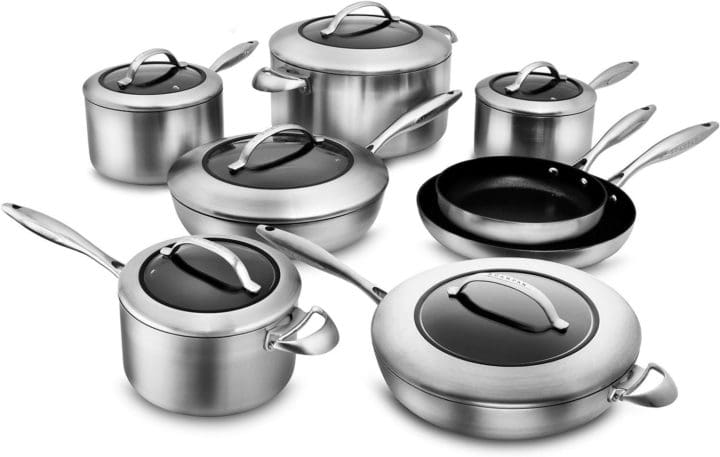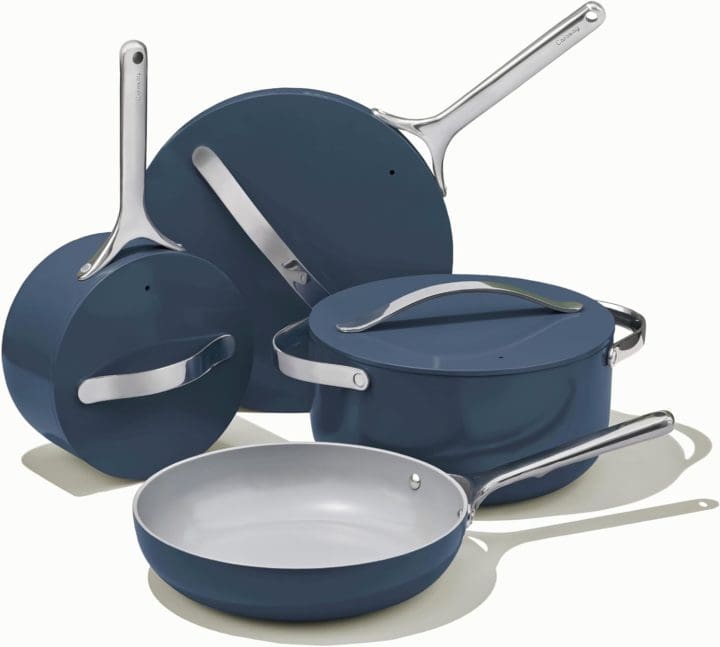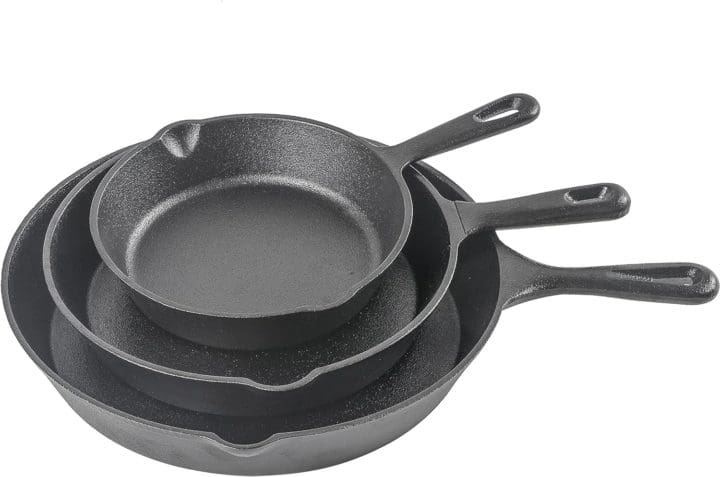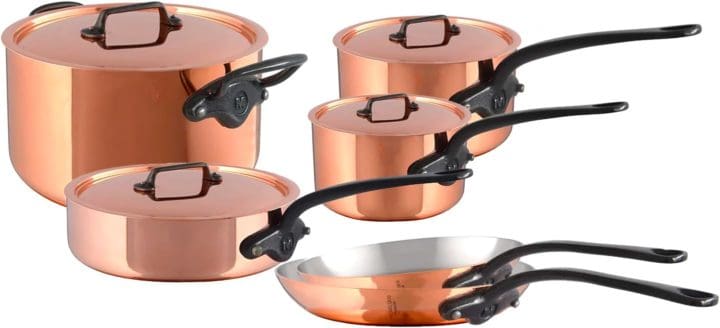Best Cookware Material
Best Cookware Material
The truth is that each kind of cookware material has pros and cons. Also, specific cooking techniques work better in certain materials. For example, the perfect pan for stir fry will be sensitive to temperature changes.
The best container for braising should hold and control heat even with temperature changes. Your goal is: to assemble the pieces that properly fit the foods you cook.
This guide will help you find out the advantages and drawbacks of cookware materials and how they may suit the cooking methods. We hope that this Best Cookware Material post inspires you.

Best Cookware Material
Stainless Steel Cookware
Stainless steel is a very tough cookware material. It’s dishwasher safe, non-porous, non-reactive, as well as impervious to corrosion, rust, scratching, and denting. Stainless steel has a gorgeous silvery finish and doesn't look outdated.
However, stainless steel isn’t a great heat conductor. To boost up the heat conductivity, copper or aluminum is utilized as an internal layer of stainless-steel cookware.
Also, it’s reasonable to use them as baking pans, yet except if they are enhanced with another kind of metal that conducts heat all more efficiently, select different materials.

Cuisinart 12-Piece Cookware Set
Pros of Stainless Steel Cookware
- Indestructible Champion: Stainless steel cookware is built to last. It's resistant to dents, scratches, and corrosion, making it a worthy investment that will be with you for years to come. Imagine heirloom pans passed down through generations, whispering tales of culinary triumphs!
- Heat Hero: Stainless steel distributes heat evenly and efficiently, ensuring consistent cooking and preventing hot spots. This culinary superpower means perfectly browned onions, fluffy pancakes, and evenly seared steaks every time.
- Versatility King: From searing to simmering, roasting to baking, stainless steel cookware handles a wide range of cooking methods like a champ. This one-pan wonder can tackle almost any recipe you throw at it.
- Non-Reactive Ninja: Unlike some other materials, stainless steel is non-reactive to acidic foods. This means no metallic flavors leaching into your delicate tomato sauce or tangy vinaigrette. Keep your culinary creations pure and delicious!
- Easy Cleaning (Mostly): While not as magical as non-stick surfaces, stainless steel cookware cleans up fairly easily with soapy water and a sponge. No more scraping up burnt bits – just a quick soak and rinse, and you're good to go.
- Induction Compatible: Most stainless steel cookware is induction-friendly, making it a great choice for modern kitchens equipped with these sleek cooktops.
Holiday Entertaining Must-Haves
Cons of Stainless Steel Cookware
- Heat Shy at First: Stainless steel can take some time to heat up compared to other materials like aluminum. Be patient during preheating, and remember, slow and steady wins the race – and the perfect sear.
- Stickiness Can Strike: While not inherently non-stick, stainless steel can get “sticky” if not preheated properly or used with the wrong amount of oil. Master the art of preheating and fat management, and you'll be rewarded with effortlessly released food.
- High Price Tag: Quality stainless steel cookware can be expensive, especially compared to other options like aluminum or non-stick. Consider it an investment in long-lasting quality and versatility.
- Weighty Workout: Stainless steel cookware is heavier than some other materials. Lifting a full Dutch oven might give your biceps a workout, so consider your lifting limits before diving in.
- Maintenance Matters: While not high-maintenance, stainless steel cookware does require some TLC. Regular cleaning and occasional seasoning with oil are key to keeping it looking its best and performing at its peak.
Stainless steel cookware has long been a favorite among home cooks and professional chefs alike. Its sleek appearance, durability, and versatility make it a kitchen workhorse.
Stainless steel cookware is a shining star for experienced cooks who appreciate quality, versatility, and long-lasting performance. Its durability and even heat distribution make it a reliable partner in the kitchen, while its non-reactive nature ensures pure flavors in your meals.
However, its initial stickiness, heat-up time, and weight may require some adjustments in your cooking technique. If you're a patient cook who embraces a little kitchen maintenance, stainless steel cookware can become your culinary confidante for years to come.
Non-Stick Cookware
Unlike other non-lined cookware materials, non-stick pans enable you to cook with less fat and is simpler to clean. Still, it isn't compatible with all sorts of cooking tasks—it’s not for multipurpose use.
Non-stick pans could be produced using various types of cookware materials such as stainless steel, copper, and aluminum. The non-stick material of surface coatings is big different from nonstick cookware.
The PTFE is the most frequently found non-stick covering, whereas other Eco-friendly choices have gained popularity over the past few years.

Scanpan CTX Stainless Steel Cookware Set
Pros of Non-Stick Cookware
- Effortless Release: The non-stick coating makes cooking and cleaning a breeze. Food practically glides across the surface, so goodbye to scraping and stuck-on messes! This is especially helpful for delicate foods like eggs, fish, and pancakes.
- Healthier Cooking: You can use less oil or fat when cooking with non-stick cookware, making your meals healthier and reducing calorie intake. Win-win!
- Easy Cleanup: The non-stick magic extends to cleaning. A quick wipe with soapy water is usually all it takes to get your pan sparkling again, saving you precious time and effort.
- Versatility: Non-stick cookware is suitable for various cooking methods, from sauteing and frying to baking and simmering. This makes it a one-pan wonder for many kitchen tasks.
- Affordable Options: Non-stick cookware comes in a range of price points, making it accessible to budget-conscious cooks.
https://divinelifestyle.com/6-best-ways-to-cook-and-serve-filet-mignon/
Cons of Non-Stick Cookware
- Delicate Darling: The non-stick coating can scratch or chip, especially if you use metal utensils or harsh scrubbing pads. Handle your pans with care to prolong their lifespan.
- High Heat Hero (But Not Always): While some non-stick cookware can handle medium heat well, high temperatures can damage the coating and release harmful chemicals. Always check the manufacturer's instructions before cranking up the heat.
- Shorter Lifespan: Compared to stainless steel or cast iron, non-stick cookware's magic might fade over time, requiring replacement sooner.
- Chemical Concerns: Some older non-stick coatings contained PFOA and PTFE, chemicals linked to health concerns. However, most modern non-stick cookware uses safer alternatives, so be sure to choose PFOA-free and PTFE-free options.
- Not Induction Friendly: Not all non-stick cookware is compatible with induction cooktops. Double-check before you buy if you have an induction hob.
Non-stick cookware has become a kitchen staple for many home cooks, thanks to its convenience and ease of use. Non-stick cookware is a great choice for home cooks who prioritize convenience and ease of use.
It's ideal for cooking delicate foods, controlling oil intake, and simplifying cleanup. However, its delicate nature and potential health concerns require careful consideration.
If you're a seasoned chef who loves high-heat cooking or are on a tight budget, other options like cast iron or stainless steel might be better suited to your needs.
Ceramic Cookware
Ceramic is the new line of non-stick cookware. It’s generally considered to be a safer and most eco-friendly alternative to this type of cookware as it's free of PTOAs and PTFEs. It doesn't leach any metallic flavor to food.

Caraway Nonstick Ceramic Cookware Set
Pros of Ceramic Cookware
- Non-Stick Superstar: The silicon oxide coating on ceramic cookware is naturally slick, making it a dream for cooking eggs, fish, and other delicate foods. Say goodbye to scraping and sticking – hello, effortless flipping!
- Healthy Hero: Unlike traditional non-stick coatings, ceramic cookware is free of PTFE and PFOA, chemicals that have been linked to health concerns. Cook with peace of mind, knowing your meals are free of unwanted nasties.
- Easy Clean Up: The non-stick magic extends to cleaning. Food releases effortlessly from the surface, so a quick wipe with soapy water is all it takes to get your pan sparkling again. No more elbow grease is required!
- Heat Handler: Ceramic cookware distributes heat evenly, preventing hot spots that can burn your food. This ensures consistent cooking and beautiful browning, making you look like a pro in the kitchen.
- Lightweight Champion: Unlike cast iron, ceramic cookware is surprisingly light, making it easy to maneuver and handle. Your wrists will thank you, especially during those long cooking sessions.
- Eco-Friendly Edge: Many ceramic cookware brands are committed to sustainability, using recycled materials and eco-friendly manufacturing processes. Feel good about cooking with a green conscience.
5 Things You Need in Your Kitchen Right Now | Tips from a Pro Chef
Cons of Ceramic Cookware
- Delicate Darling: The ceramic coating, while impressive, is more fragile than other materials like stainless steel. Avoid metal utensils and harsh scrubbing to keep your pan scratch-free.
- Heat Shy: While it handles medium heat well, ceramic cookware shouldn't be blasted to high temperatures. This can damage the coating and shorten its lifespan.
- Shorter Lifespan: Compared to cast iron or stainless steel, ceramic cookware's non-stick magic might fade over time, requiring replacement sooner.
- Pricey Pick: Ceramic cookware tends to be more expensive than traditional non-stick options. Consider it an investment in your health and cooking experience.
- Not Induction Friendly: Not all ceramic cookware is compatible with induction cooktops. Double-check before you buy if you have an induction hob.
Ceramic cookware has become a popular choice for health-conscious cooks thanks to its sleek design, non-stick prowess, and chemical-free promise.
Ceramic cookware is a fantastic choice for health-conscious cooks who value convenience and easy cleanup. Its non-stick prowess and chemical-free appeal make it a winner in the health department.
However, its delicate nature and shorter lifespan require a bit more care and attention.
Cast Iron Cookware
Cast iron is among one of the most versatile and vigorous cookware materials. You can cook nourishment anyplace with cast iron cookware from oven to grill.
However, cast iron requires additional care for cleaning and storing—especially needs seasoning to shield it from rust.
Other than securing rust, seasoning makes a wonderfully natural non-stick surface. Although cast iron is reactive to acidic foods, the seasoning can moderately help prevent this issue.

Commercial CHEF Cast Iron Skillet Set
Pros of Cast Iron Cookware
- Indestructible: Built to last a lifetime (and then some!), cast iron can handle high heat, accidental drops, and even metal utensils without flinching. Think of it as the Incredible Hulk of the cookware world.
- Heat Master: Cast iron's thick walls absorb and distribute heat evenly, ensuring perfectly cooked food with a beautiful sear. Imagine sizzling steaks and fluffy pancakes, cooked to perfection.
- Naturally Non-Stick: Once seasoned, cast iron develops a naturally non-stick surface that rivals the best chemical coatings. Say goodbye to scraping and sticking!
- Versatile Superstar: From searing to slow-cooking, cast iron is a culinary chameleon. Skillets, Dutch ovens, griddles – the possibilities are endless!
- Budget-Friendly: Despite its quality, cast iron is surprisingly affordable, especially compared to other high-end cookware. Think of it as an investment that will pay off for years to come.
Skillet Vanilla Protein Pancakes Recipe
Cons of Cast Iron Cookware
- The Weight Game: Cast iron is heavy, no ifs, ands, or buts. Lifting and maneuvering a Dutch oven full of stew can be a workout.
- Slow and Steady: Heating cast iron takes time, so patience is key. Forget about quick stir-fries – cast iron is all about slow cooking and savoring the process.
- Rust Never Sleeps: Cast iron is prone to rust if not properly cared for. Regular drying and seasoning are essential to keep your pan in tip-top shape.
- Acid Test: Cast iron can react with acidic foods, affecting their taste and potentially leaching iron. Stick to neutral or alkaline dishes to avoid this.
- High Maintenance: Unlike the “set it and forget it” convenience of some cookware, cast iron requires regular upkeep. Washing, drying, and seasoning are part of the cast iron experience.
Cast iron is a love-it-or-hate-it kind of cookware. Its strengths are undeniable, but its quirks can be a dealbreaker for some.
If you're a patient cook who appreciates quality and doesn't mind a little extra TLC, cast iron will reward you with a lifetime of delicious meals and culinary adventures. Just remember, cast iron is more than just a pan; it's an heirloom waiting to be made.
Copper Cookware
Copper cookware has long been a favorite among chefs for its stunning good looks and exceptional heat conductivity.
Copper cookware is a dream for serious home cooks and professional chefs who appreciate its unparalleled performance and timeless beauty.
However, its high cost, maintenance requirements, and limitations make it less ideal for casual cooks or those on a budget.

Mauviel M'Heritage Copper Cookware Set With Cast Iron Handles
Pros of Copper Cookware
- Superior Heat Distribution: Copper is a champion conductor of heat, ensuring even cooking and eliminating hot spots. This means perfectly caramelized scallops, fluffy omelets, and sauces that don't scorch.
- Responsive Temperature Control: Say goodbye to overcooked meals! Copper pans react quickly to heat changes, letting you sear, simmer, and sauté with precision.
- Durable and Long-Lasting: Properly cared for, copper cookware can be your culinary companion for generations. Its thick construction stands up to years of use.
- Aesthetic Appeal: Let's face it, copper cookware is simply gorgeous. Its warm hue adds a touch of elegance to any kitchen.
Mauviel M'Heritage Copper Cookware
Cons of Copper Cookware
- High Price Tag: Copper cookware is a luxury item, with prices significantly higher than other materials like stainless steel or cast iron.
- High Maintenance: Copper is prone to tarnishing and requires regular polishing to maintain its shine. Avoid harsh abrasives, as they can scratch the surface.
- Reactivity: Copper can react with acidic foods, causing them to discolor or leach metallic flavors. Tin or stainless steel linings help mitigate this but add to the cost.
- Not Induction-Friendly: Traditional copper pans won't work on induction cooktops. Look for pans with a compatible base if you have an induction cooktop.
- Weighty: Copper pans are heavier than other types of cookware, which can be tiring for some cooks.
If you're a passionate cook who appreciates quality, can handle the occasional polishing session, and doesn't mind investing in culinary excellence, then copper cookware can be the missing piece in your kitchen symphony.
Just remember, treat it with love, and it will reward you with a lifetime of delicious meals and culinary adventures!
Taking everything into account, which cookware to pick for your kitchen depends on you. Remember, don’t forget to think about your frequent cooking cuisines because each cooking material fits a different skill.
At whatever point you need to purchase one, make sure that you know it before buying.





Pingback: Most Durable Cookware for the Home Chef Divine Lifestyle
Pingback: Le Creuset Dutch Oven 5.5 Qt
Pingback: Le Creuset Enamel Stock Pot